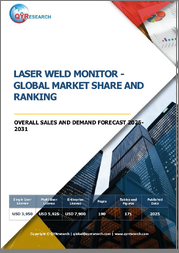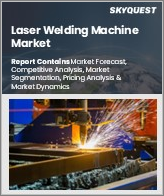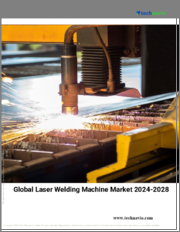
|
시장보고서
상품코드
1447629
로봇 레이저 용접 시장 : 구성별, 기술별, 페이로드별, 최종 용도별, 예측(2024-2032년)Robotics Laser Welding Market - By Component (Hardware, Software, Service), By Technology (Fiber Laser Welding Robots, CO2 Laser Welding Robots, Solid-state Laser Welding Robots), By Payload, By End-use, Forecast 2024 - 2032 |
||||||
세계의 로봇 레이저 용접 시장은 기술의 진보와 다양한 산업에서의 수요 증가에 의해 지원되며 2024-2032년에 CAGR 8.5%로 성장할 것으로 예측되고 있습니다.
옥스포드 대학의 보고서에 따르면 2030년까지 제조업의 자동화로 인해 전 세계 매출이 연간 4조 9,000억 달러가 증가할 것으로 예상됩니다. 생산성 향상과 제품 품질 유지를 위해 제조 공정의 자동화가 중요해지면서 로봇 레이저 용접 시스템에 대한 수요가 급증하고 있습니다. 또한 연비 향상과 배기가스 배출량 감소를 위한 경량 자동차 제조 증가 추세는 로봇 레이저 용접이 알루미늄 및 복합재료와 같은 경량 재료의 접합에 적합하기 때문에 시장 성장을 더욱 촉진하고 있습니다.
로봇 및 레이저 용접 기술의 지속적인 발전도 업계의 성장을 가속하고 있습니다. 고출력 레이저, 정밀도와 유연성이 향상된 첨단 로봇 시스템, 통합 소프트웨어 솔루션과 같은 혁신을 통해 제조업체는 용접 공정에서 더 높은 수준의 생산성, 효율성 및 품질을 달성할 수 있게 되었습니다.
소프트웨어 컴포넌트 부문은 용접 공정을 정확하게 제어하고 모니터링하는 데 중요한 역할을 하기 때문에 2032년까지 상당한 수요를 기록할 것으로 예상됩니다. 첨단 소프트웨어 솔루션은 용접 파라미터의 실시간 조정을 용이하게 하고, 일관된 용접 품질을 보장하며, 결함을 최소화할 수 있습니다. 이러한 소프트웨어 패키지는 시뮬레이션 툴, 공정 최적화 알고리즘, 데이터 분석 기능 등의 기능을 제공하여 제조업체가 용접 작업을 최적화하고 효율성과 생산성을 극대화할 수 있도록 돕습니다.
로봇 레이저 용접이 제공하는 높은 정밀도와 반복성은 항공우주 분야에서 요구되는 엄격한 품질 및 안전 기준을 충족하는 데 필수적입니다. 마찬가지로, 방위 산업은 로봇 레이저 용접을 사용하여 장갑차, 무기 시스템 및 기타 방위 장비 제조에 로봇 레이저 용접을 활용하고 있으며, 용접 조인트의 내구성과 신뢰성이 가장 중요한 요소입니다.
아시아태평양의 로봇 레이저 용접 시장은 중국, 일본, 한국, 인도 및 기타 국가의 급속한 산업화와 제조업 성장으로 인해 2024-2032년 괄목할 만한 성장을 기록할 것으로 예상됩니다. 주요 제조업체들이 자동차 수요 증가에 대응하기 위해 첨단 용접 기술을 채택하는 자동차 부문의 호황은 향후 수년간 이 지역 시장 확장을 촉진할 것입니다.
목차
제1장 조사 방법과 조사 범위
제2장 주요 요약
제3장 업계 인사이트
- 에코시스템 분석
- 공급업체 상황
- 이익률 분석
- 기술 혁신 상황
- 특허 분석
- 주요 뉴스와 구상
- 규제 상황
- 영향요인
- 촉진요인
- 자동차 및 항공우주 산업의 성장
- 고품질 용접의 수요
- 제조 활동의 세계 확대
- 레이저 기술과 로봇공학의 지속적 진보
- 경량 재료의 수요
- 업계의 잠재적 리스크 & 과제
- 초기 도입 비용
- 기존 시스템과의 통합
- 촉진요인
- 성장 가능성 분석
- Porter의 산업 분석
- PESTEL 분석
제4장 경쟁 구도
- 서론
- 기업 점유율 분석
- 경쟁 포지셔닝 매트릭스
- 전략 전망 매트릭스
제5장 시장 추산·예측 : 컴포넌트별, 2018-2032년
- 주요 동향
- 하드웨어
- 로봇
- 용접 기기
- 센서와 비전 시스템
- 소프트웨어
- 컨트롤러 소프트웨어
- 시뮬레이션 소프트웨어
- 서비스
제6장 시장 추산·예측 : 기술별, 2018-2032년
- 주요 동향
- 파이버 레이저 용접 로봇
- Co2 레이저 용접 로봇
- 고체 레이저 용접 로봇
제7장 시장 추산·예측 : 페이로드별, 2018-2032년
- 주요 동향
- 50kg 페이로드 미만
- 50-150kg 페이로드
- 150kg 페이로드 이상
제8장 시장 추산·예측 : 용도별, 2018-2032년
- 주요 동향
- 자동차·운송
- 금속·기계
- 전기·전자
- 항공우주·방위
- 기타
제9장 시장 추산·예측 : 지역별, 2018-2032년
- 주요 동향
- 북미
- 미국
- 캐나다
- 유럽
- 영국
- 독일
- 프랑스
- 이탈리아
- 스페인
- 러시아
- 기타 유럽
- 아시아태평양
- 중국
- 인도
- 일본
- 한국
- 뉴질랜드
- 기타 아시아태평양
- 라틴아메리카
- 브라질
- 멕시코
- 기타 라틴아메리카
- 중동 및 아프리카
- 남아프리카공화국
- 사우디아라비아
- 아랍에미리트
- 기타 MEA
제10장 기업 개요
- ABB Ltd.
- CLOOS
- COMAU S.P.A.
- Daihen Corporation
- EVS TECH CO., LTD
- Fanuc Corporation
- Kuka AG
- Kawasaki Heavy Industries, Ltd.
- Miller Electric Mfg. LLC
- Nachi-Fujikoshi Corp.
- Panasonic Corporation
- Tata Motors Limited
- Universal Robots A/S
- Yaskawa Electric Corporation
The global robotics laser welding market is expected to grow at a CAGR of 8.5% during 2024-2032, fueled by advancements in technology and increasing demand across various industries.
An Oxford report projects that by 2030, automation in manufacturing could boost global revenues by $4.9 trillion annually. The growing emphasis on automation in manufacturing processes to enhance productivity and maintain product quality is fueling the demand for robotics laser welding systems. Moreover, the rising trend of lightweight vehicle manufacturing to improve fuel efficiency and reduce emissions is further boosting the market growth, as robotics laser welding is well-suited for joining lightweight materials like aluminum and composites.
Continuous advancements in robotics and laser welding technologies are also driving industry growth. Innovations such as high-power lasers, advanced robotic systems with increased precision & flexibility, and integrated software solutions are enabling manufacturers to achieve higher levels of productivity, efficiency, and quality in the welding processes.
The overall robotics laser welding industry is classified based on component, technology, payload, end-use, and region.
The software component segment is anticipated to record notable demand by 2032, owing to its vital role in enabling precise control and monitoring of welding processes. Advanced software solutions facilitate real-time adjustments to welding parameters, ensuring consistent weld quality and minimizing defects. These software packages also offer features such as simulation tools, process optimization algorithms, and data analytics capabilities, empowering manufacturers to optimize their welding operations for maximum efficiency and productivity.
The aerospace & defense end-use segment is poised to grow substantially till 2032, as high precision and repeatability offered by robotics laser welding are essential for meeting the stringent quality and safety standards required in the aerospace sector. Similarly, the defense industry utilizes robotics laser welding for manufacturing armored vehicles, weapons systems, and other defense equipment, where the durability and reliability of welded joints are paramount.
Asia Pacific robotics laser welding market is set to record a notable growth during 2024 and 2032, driven by the rapid industrialization and growing manufacturing sector in countries such as China, Japan, South Korea, and India. The booming automotive sector with leading manufacturers adopting advanced welding technologies to meet the increasing demand for vehicles will bolster the regional market expansion in the coming years.
Table of Contents
Chapter 1 Methodology & Scope
- 1.1 Market scope & definitions
- 1.2 Base estimates & calculations
- 1.3 Forecast calculations
- 1.4 Data sources
- 1.4.1 Primary
- 1.4.2 Secondary
- 1.4.2.1 Paid sources
- 1.4.2.2 Public sources
Chapter 2 Executive Summary
- 2.1 Industry 360 degree synopsis, 2018-2032
Chapter 3 Industry Insights
- 3.1 Industry ecosystem analysis
- 3.2 Supplier landscape
- 3.3 Profit margin analysis
- 3.4 Technology & innovation landscape
- 3.5 Patent analysis
- 3.6 Key news & initiatives
- 3.7 Regulatory landscape
- 3.8 Impact forces
- 3.8.1 Growth drivers
- 3.8.1.1 Growth in automotive and aerospace Industries
- 3.8.1.2 Demand for high-quality welding
- 3.8.1.3 Global expansion of manufacturing activities
- 3.8.1.4 Ongoing advancements in laser technology and robotics
- 3.8.1.5 Demand for lightweight materials
- 3.8.2 Industry pitfalls & challenges
- 3.8.2.1 Initial implementation costs
- 3.8.2.2 Integration with existing systems
- 3.8.1 Growth drivers
- 3.9 Growth potential analysis
- 3.10 Porter's analysis
- 3.10.1 Supplier power
- 3.10.2 Buyer power
- 3.10.3 Threat of new entrants
- 3.10.4 Threat of substitutes
- 3.10.5 Industry rivalry
- 3.11 PESTEL analysis
Chapter 4 Competitive Landscape, 2023
- 4.1 Introduction
- 4.2 Company market share analysis
- 4.3 Competitive positioning matrix
- 4.4 Strategic outlook matrix
Chapter 5 Market Estimates & Forecast, By Component, 2018-2032 (USD Million)
- 5.1 Key trends
- 5.2 Hardware
- 5.2.1 Robots
- 5.2.2 Welding equipment
- 5.2.3 Sensors and vision systems
- 5.3 Software
- 5.3.1 Controller software
- 5.3.2 Simulation software
- 5.4 Services
Chapter 6 Market Estimates & Forecast, By Technology, 2018-2032 (USD Million)
- 6.1 Key trends
- 6.2 Fiber laser welding robots
- 6.3 Co2 laser welding robots
- 6.4 Solid-state laser welding robots
Chapter 7 Market Estimates & Forecast, By Payload, 2018-2032 (USD Million)
- 7.1 Key trends
- 7.2 < 50 kg payload
- 7.3 50-150 kg payload
- 7.4 Above 150 kg payload
Chapter 8 Market Estimates & Forecast, By End-Use, 2018-2032 (USD Million)
- 8.1 Key trends
- 8.2 Automotive & transportation
- 8.3 Metals & machinery
- 8.4 Electrical & electronics
- 8.5 Aerospace & defense
- 8.6 Others
Chapter 9 Market Estimates & Forecast, By Region, 2018-2032 (USD Million)
- 9.1 Key trends
- 9.2 North America
- 9.2.1 U.S.
- 9.2.2 Canada
- 9.3 Europe
- 9.3.1 UK
- 9.3.2 Germany
- 9.3.3 France
- 9.3.4 Italy
- 9.3.5 Spain
- 9.3.6 Russia
- 9.3.7 Rest of Europe
- 9.4 Asia Pacific
- 9.4.1 China
- 9.4.2 India
- 9.4.3 Japan
- 9.4.4 South Korea
- 9.4.5 ANZ
- 9.4.6 Rest of Asia Pacific
- 9.5 Latin America
- 9.5.1 Brazil
- 9.5.2 Mexico
- 9.5.3 Rest of Latin America
- 9.6 MEA
- 9.6.1 South Africa
- 9.6.2 Saudi Arabia
- 9.6.3 UAE
- 9.6.4 Rest of MEA
Chapter 10 Company Profiles
- 10.1 ABB Ltd.
- 10.2 CLOOS
- 10.3 COMAU S.P.A.
- 10.4 Daihen Corporation
- 10.5 EVS TECH CO., LTD
- 10.6 Fanuc Corporation
- 10.7 Kuka AG
- 10.8 Kawasaki Heavy Industries, Ltd.
- 10.9 Miller Electric Mfg. LLC
- 10.10 Nachi-Fujikoshi Corp.
- 10.11 Panasonic Corporation
- 10.12 Tata Motors Limited
- 10.13 Universal Robots A/S
- 10.14 Yaskawa Electric Corporation



















